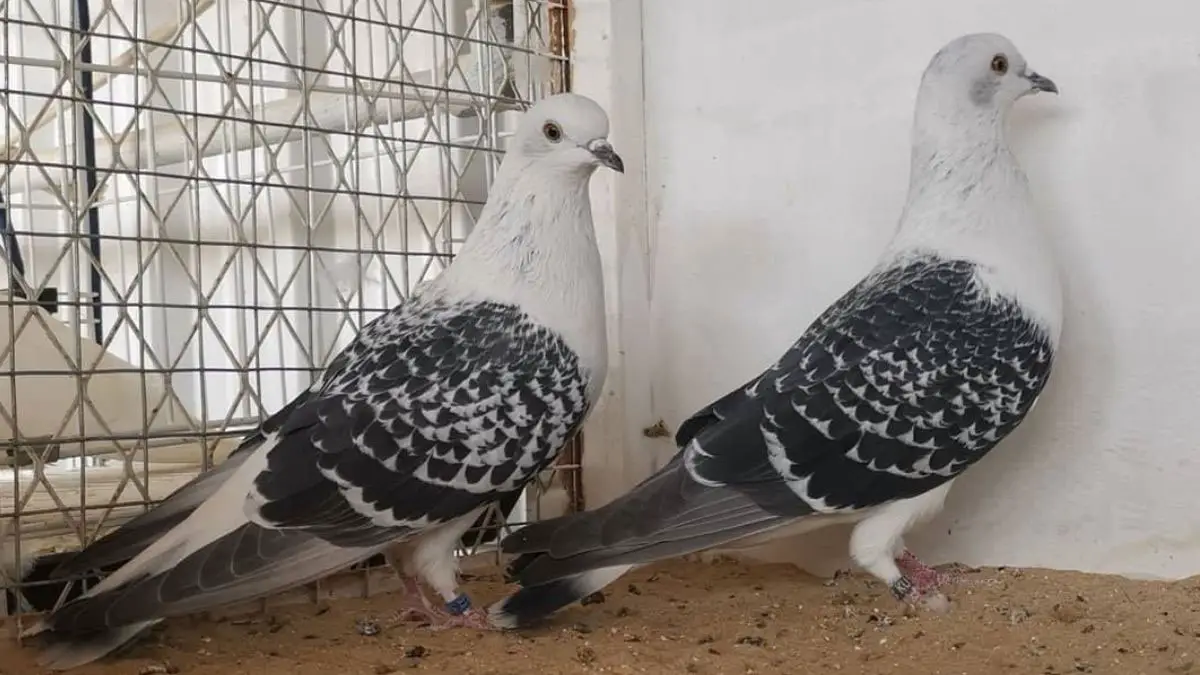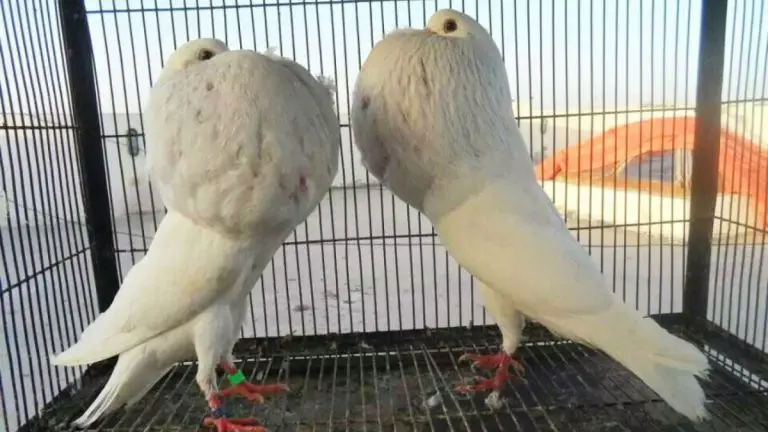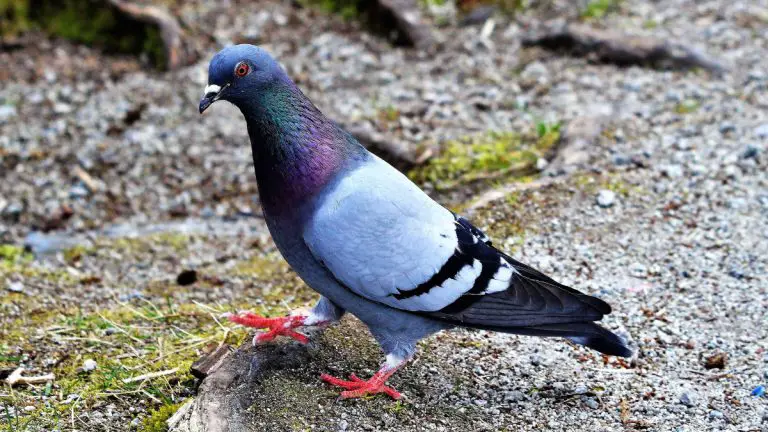Ice Pigeon: Origin, Appearance, Behavior, Care, And More
The ice pigeon is one of the most common breeds of pigeons across the globe. This breed is known for its unique coloration which comprises a striking combination of black and white or gray.
This distinctive appearance has earned the bird a spot in most pigeon shows and competitions around the world.
This pigeon breed is also popular among pet pigeon enthusiasts for its friendly and docile nature. Plus, it’s low maintenance and easy to care for.
In this article, we have covered everything you need to know about the ice pigeon, including its history and origin, looks and distinctive features, personality traits, and more.
Ice Pigeon Facts:
| Scientific name | Columba livia domestica |
| Other names | Eistaube (German), Lazurek (Polish) |
| Breed name | Ice |
| Origin | Germany |
| Breed purpose | Ornamental, exhibition, pets |
| Size | Medium |
| Weight | |
| Lifespan | Up to 10 years |
| Flying ability | Moderate |
| Cost | From $100 to thousands of dollars |
Ice pigeon origin and history
Ice pigeon was first developed in the region between Eastern Germany and Western Poland, and is regarded as one of the oldest breeds of Germany.
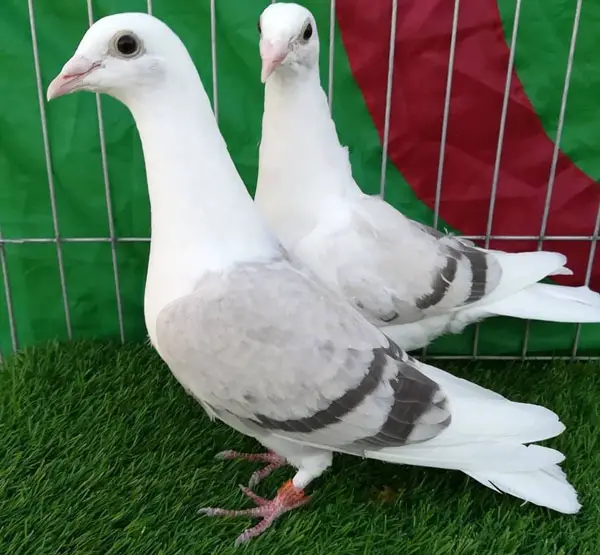
The bird is a result of many years of selective breeding. The earliest breeding of the pigeon can be traced to Saxony and Silesia.
It’s also interesting to note that and was cross-bred by Charles Darwin in 1846 with the aim of ascertaining colors and patterns. (Source).
Appearance
The ice pigeon is a medium-sized bird and gets its name from its ice-blue coloration. It features a slightly oblong and smooth head.
Note that this breed has several varieties which are set apart by the patterned wing and type of color features. However, the basic color of this pigeon is gray.
The eyes of this bird also differ depending on the variety. All the varieties feature black eyes, except for the black barred and checked varieties whose eyes are orange to yellow-orange.
The neck of this pigeon is usually medium long and appears gently stretched forward. Its beak is also medium to long, slender, and dark in appearance.
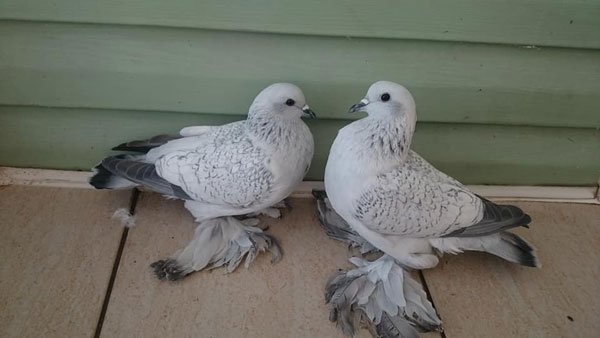
As for the chest, this pigeon has a deep and broad chest with a forward stretching appearance. Its wings are pretty long and rest toward the tail.
The back is usually broad around the shoulder and gets narrower as you move toward the tail.
The tail is usually long and appears perfectly closed. Some of the varieties also have feathered feet while some are clean-legged.
Check the following video of the most common ice pigeon varieties
Video:
Behavior and personality traits
Ice pigeons are generally friendly and calm birds, which makes them a good choice of pigeon breed for a pet.
They’re also intelligent birds, so training them to do various tricks is pretty easy. For instance, you can train your bird to learn its name and it will fly to you when you call it.
We advise you to normalize your bird to real life’s hustle and bustle and not lock it away most of the time. This is the best way to make it fairly docile and calm as a pet.
You’ll hear your ice pigeon cooing or whistling if it’s in good mood. But if you hear it making it grunting sounds, then it’s in a sad mood.
They also tend to get along pretty well with other pigeon birds. However, we recommend keeping different bird breeds in a spacious enclosure to prevent the possibility of conflict.
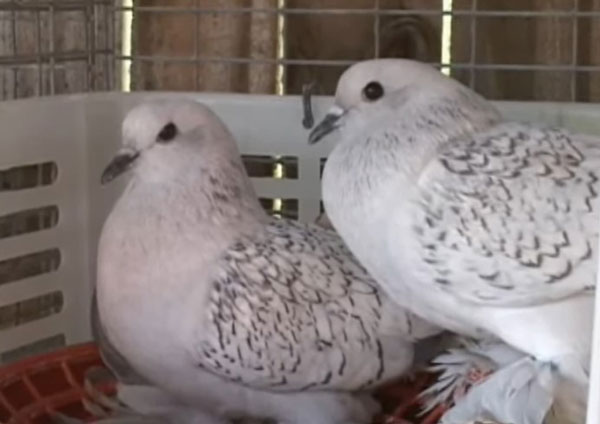
Since these birds are decent flyers, you should securely lock them up in a protected area. The birds can fly for pretty long distances, making them suitable for transportation and travel.
For those who plan to use the ice pigeon for decorative purposes, then you’ll be pleased to know it’s not a high-maintenance pet bird.
But you’ll need to keep it clean. Keeping it in an extensive airy outdoor environment greatly helps preserve its feather quality.
Ice pigeon diet
The diet of a pigeon isn’t different from that of many other breeds of pigeon. It usually feeds on pigeon pellets, seeds, fruits, and veggies. (Source).
However, it’s important to provide your pigeon with a varied diet of these foods to ensure it reeves all the essential nutrients.
Some of the food varieties to consider feeding this bird include seeds+grains mix, e.g. maize, paddy, wheat, enamel, rice, legume, gram, mustard, etc.
As for the feeding frequency, you should feed your budgie around twice every day.
If you have multiple pigeons, it’s advisable to ensure they have food in their house throughout the day.
Don’t forget to provide the bird with clean and fresh water.
Keeping ice pigeons as pets
You can keep an ice pigeon as a pet. It makes a good companion due to its friendly and docile nature. It also requires low care and maintenance.
However, it may not be a good option for beginners. If you’ve never kept a pigeon before, we recommend getting a homing pigeon that hasn’t flown before.
That said, you’ll need to make sure you take good care of this bird to keep it healthy and happy.
Grooming is one way you should good care of your pigeon. This is as simple as regularly trimming its feathers and nails. Occasional bathing is also recommended to keep its feather clean and healthy.
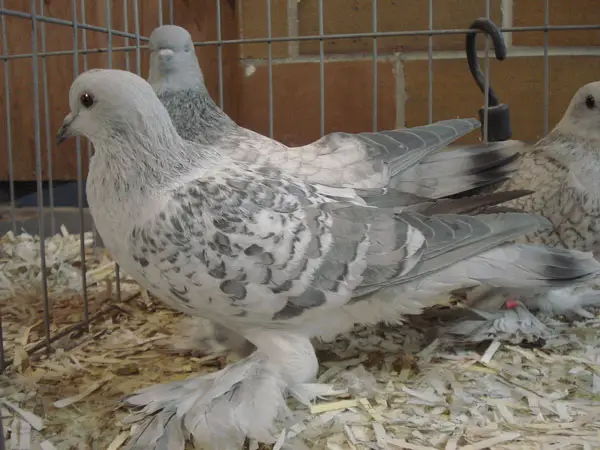
As for the ice pigeon habitat, you can keep this bird in a loft. Just make sure it has adequate space for the bird to freely move around in addition to easy access to food and water in its housing.
The loft should be large enough to accommodate your bird’s wingspan (which is approx. 6 feet). The ideal cage should also offer plenty of room for stretching out and horizontal bars to facilitate perching.
Ensure you regularly clean your bird’s housing to help you maintain a clean and healthy living environment for your budgie. Be sure to wipe down surfaces, remove any soiled beddings, and clean the food dishes and water bowls.
Above all, monitor the health of your birds and always consult your vet if you notice any signs of health problems or sudden changes in behavior.
Breeding
Breeding your ice pigeon is possible, just like it’s the case with other types of pigeons. However, there are a few things to keep in mind to ensure you do everything correctly.
You should start by getting a suitable nesting box for your pigeon. Get comfortable bedding that doesn’t look too old or rough. This will ensure the babies will feel comfortable on the bedding once they get hatched.
These pigeons are capable of withstanding slightly colder temperatures compared to other breeds. However, you shouldn’t expose them to extremely cold temperatures as they won’t be able to tolerate them.
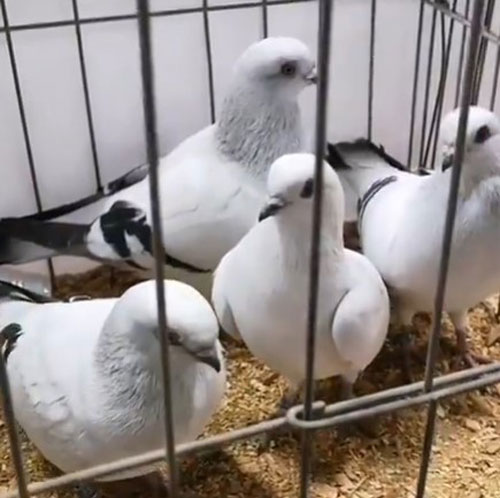
Maintain decent temperatures to keep your pigeons’ breeding area warm. This will help save your bird and offspring from suffering in case it gets too cold.
If you live in colder climate regions, using items like grass, pine needles, twigs, hay, wood chips, etc., can help keep the nests warmer and trap heat for longer periods of time.
When breeding more than a pair of this pigeon, consider getting multiple nests for each pair. This will give each pair the freedom to choose the location they prefer.
Ice pigeon price
You should be prepared to spend anywhere from 100 to upward of thousands of dollars on an ice pigeon.
The exact cost of the pigeon will be greatly determined by factors such as the breeder, location, and age.
Some breeders won’t sell just one bird to you; they prefer selling to you in bulk.
Keep in mind that show pigeons that are high-quality tend to be quite pricey and can easily surpass $1000 in costs.
It’s not uncommon for a show pigeon to sell for as high as 10,000 dollars and more!
Since the ice pigeons are also show/exhibition birds, you can easily guess that their prices can also get quite high.
Ice pigeon lifespan
The ice pigeon can live for up to 10 years with proper care. However, its longevity can be easily affected by factors such as genetics, living conditions, and the diet you feed it.

You can extend your pigeon’s lifespan by keeping it in clean and healthy living conditions, providing it with a nutritious diet, and keeping its health in check by regularly visiting an avian vet for routine check-ups.
If you’re interested in learning more about pigeon breeds, you might find our articles on Homer pigeons and English Trumpeter pigeons helpful. Our article on Homer pigeons provides an in-depth look at the history, characteristics, and care of these popular birds. Meanwhile, our article on English Trumpeter pigeons explores the origins, traits, and breeding practices of this fascinating breed.Final Verdict
The ice pigeon is beautiful and comes in a wide variety of colors, which makes it a great choice for exhibition and ornamental purposes. Its friendly and calm nature makes it ideal for keeping as a pet. Breeding this bird is also pretty easy as you just need to ensure you provide it with a suitable nesting box and maintain decent temperatures in its nesting area. Hopefully, you’ve learned new and interesting facts about ice pigeons in this guide, including their origin/history, temperament, diet, habitat, lifespan, cost, personal traits, and how to take good care of them as pets.
